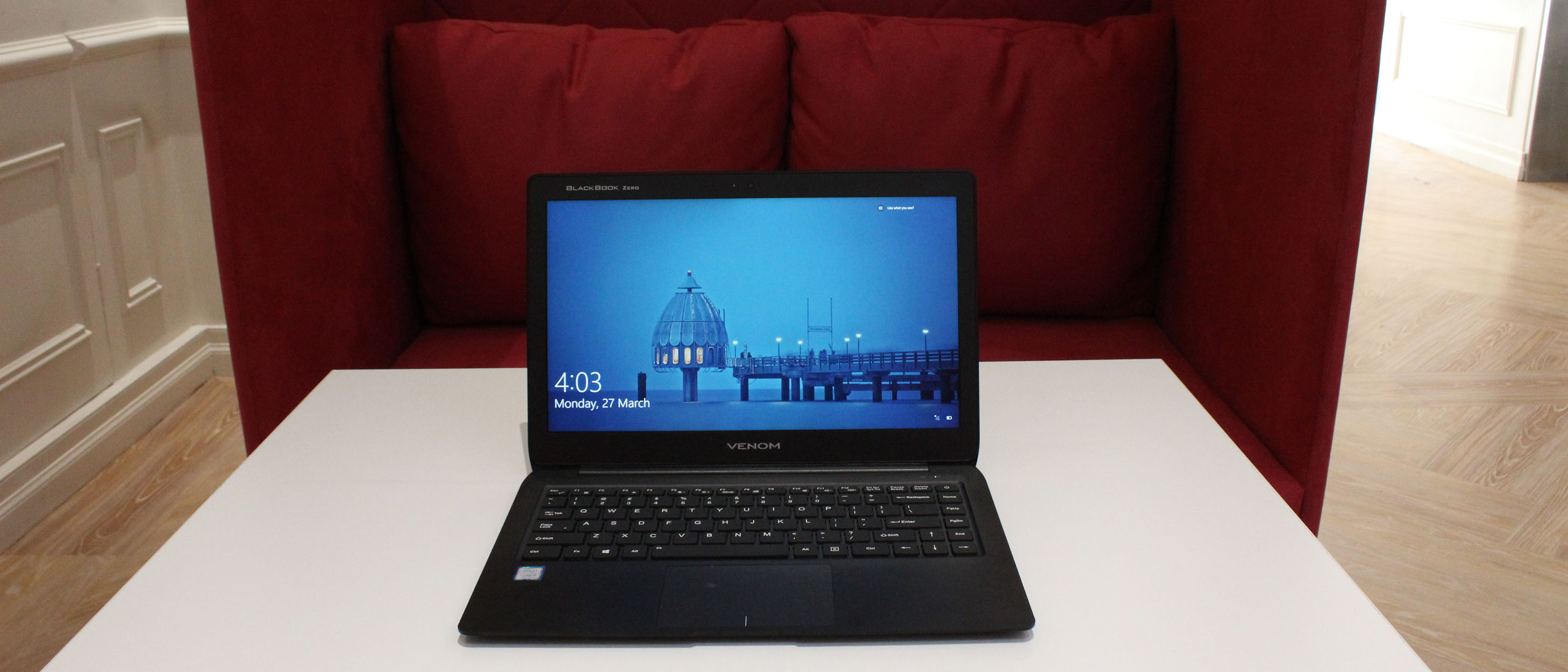TechRadar Verdict
Long battery life, a good cost-to-power ratio, sleek looking design, high portability and the lack of bloatware makes the BlackBook Zero 14 an excellent choice of Ultrabook.
Pros
- +
All-day battery life
- +
Includes two chargers
- +
Has minimum Photoshop specs
- +
Doesn't get too hot
Cons
- -
Core M CPU only up for light multimedia work
- -
Average media encoding speed
- -
Slightly different keyboard layout
Why you can trust TechRadar
Some of the biggest breakthroughs in the ultraportable laptop category over the last year have taken the form of more compact cooling architecture – something that's allowed full-spec Intel Core i5 and i7 laptop CPUs to squeeze into sub 1.5cm (⅝ inch) laptop chassis'. As a result, many of our recommended slim-and-light laptops often feature powerful components that professional customers won’t mind paying a premium for.
With Intel's power-saving Core M CPU family now into it’s third generation, however, the chip giant has been making steady gains in overall performance when compared to the 'real' Core i5 and i7 mobile CPUs. In fact, it’s now at the point where the latest Kaby Lake Core M chips can meet the minimum specs for demanding applications like Photoshop, and for many professional users that'll be all they really require. Intel's so confident that it's even rebranded Core M processors to use the same Core i3, i5 and i7 naming scheme – the giveaway is that the contain a Y in the model identifier number, such as Core i5-7Y75.
When you factor in that Core M also offers better power efficiency and removes the need for active fan-based cooling – and all the breakable and dust-gathering moving parts that come with it – then there's arguably never been a better time to make an Ultrabook with a Core M processor. Venom’s new BlackBook Zero 14 is hoping to appeal to the creatives or professionals who'd prefer to spend a little less on a system but still get a system that has enough power to do everything they want.
Price and availability
The Venom BlackBook Zero 14 range is currently available through Venom’s online global store (or www.mln.com.au in Australia) with prices starting at $999 (£829.86 and AU$1,499) for the Intel Core i5, 128GB model. A unit with the same Core i5 processor and a larger 240GB SSD goes for $1,099 (£912.93 and AU$1,699), while the largest 500GB SSD variant comes in at $1,199 (£996 AU$1,899). The BlackBook Zero 14s with faster Intel Core i7 CPUs start with a 240GB SSD model for $1,249 (£1,037.54 and AU$1,949), with a larger capacity 500GB Core i7 model landing at $1,349 (£1,120.61 and AU$2,149) and the largest capacity 1TB SSD Core i7 model costing $1,549 (£1,286.75 and AU$2,549).
Design
With a body honed from a black sandblasted metal alloy composite, this 1.4kg (3 pound) clamshell is around 15% heavier than the lighter 2-in-1s and Ultrabooks that you’d generally pit it against. It might seem counter-intuitive for an ultraportable unit to intentionally pack on the pounds, but when you consider that its extra weight is mostly due to the sturdy metal chassis and its fractionally bigger 14.1-inch screen, it’s a trade-off we think many people will be willing to take.
Balancing the two halves of this black metal laptop is a sturdy hinge that has a soft resistance, allowing the screen to be tilted without having to hold onto the base. We hope that the hinge, like the rest of the laptop, has been built for longevity, as the one on our test unit did sit on the looser end of the spectrum already.
At a total folded thickness of 14mm (0.55in), the BlackBook Zero 14 slips nicely into carry cases, briefcases and backpacks and the accompanying diminutive charger and cable makes it an exceptionally portable package on the whole.
Keyboard and trackpad
Continuing the matte-black theme is a black-coloured chiclet keyboard that has powdery soft-to-touch keys. The key travel distance feels generous for a device this thin and we were happy with the responsiveness and strong feedback for a membrane keyboard.
The only grievance we had was that the Home, 'Page Up', 'Page Down' and End keys sit at the far right edge of the unit, making the Backspace, Enter and Shift keys slightly out of a regular alignment. This has been done in a way that makes sense for any power users who are willing to tweak their keyboard techniques and use their pinky for fast scrolling, but it will likely create problems for new users. That's mainly because the Home button sits just outside the Backspace key, so it was common for us to nudge it rather than delete a mistake, meaning the tail end of a sentence was regularly spliced into the beginning of a paragraph.
The trackpads on Windows PCs have, on the whole, gotten significantly better in the past few years, and though we have no complaints with the temperament and performance of the BlackBook Zero 14’s powdery-finished trackpad, it’s still a little shy of a MacBook or even ASUS ZenBook experience. That said, it's notably better when it comes to responsiveness than many PC laptops and it was easy enough to become accustomed to in our testing.

CPU
Venom’s Managing Director and Chief Designer Jaan Turon said that the decision for an Intel Core M CPU in the BlackBook Zero 14 was driven by the long term thermal benefits and prolonged physical integrity of computers that don’t require fans. “We were getting a lot of feedback from customers saying that the heat of laptops on their laps was a big problem,” he told us, “and fans, when they are this small, have a tendency to make a lot of noise and collect dust over time, which will eventually cause issues in performance.
"Our engineers did a lot of work restructuring the internals of the BlackBook Zero 14 to accommodate a CPU that didn’t need fans, so we could pass on those longer term benefits to our customers.”
We haven’t had the BlackBook 14 for quite long enough to verify whether the unit is more robust than Ultrabooks requiring fans, but the internal thermals are quite moderate (considering the performance) and the chassis definitely has less intense hotspots than many thin-and-light laptops we’ve tested. This reduction in heat stems from the Intel Core i5-7Y75 CPU’s lower base operating frequency of 1.2GHz, which generally sits at around 80ºC (176ºF) in intensive work or home usage conditions in ambient temperatures of 20 to 25ºC (68-77ºF), although when pushed to the extreme it can reach up to 86ºC (186ºF) at times. Under a similar load, the SOC draws 14.66W which is about 17.5% less than a Skylake Core i5-6200U. When running PCMark 8’s general home usage and work benchmarks, the BlackBook Zero 14 hits 3,088 and 4,210 respectively — scores that are almost identical to the ASUS ZenBook Flip UX360UA’s more powerful Core i5-6200U chip. For an Ultrabook aimed at professionals, this is exactly the level of performance you generally want, and it’s encouraging that Venom’s managed to get this result using a more-efficient but less powerful chip.
The Core M chips don’t hold up so well in the multimedia-oriented tasks that are tested by Cinebench’s multi-threaded and single-core CPU rendering benchmarks, where the ASUS UX360UA’s older Core i5 came off better, with respective scores of 268 and and 112, against the BlackBook Zero 14’s scores of 174 in multi-threaded and 71 in single-core CPU. That's a considerable difference and though this specific category of Ultrabook arguably isn’t aimed at users looking to do that kind of intense rendering work, this is likely to be the area where you will see the biggest difference in performance from Intel’s Core M chips. That said, in subjective testing we found that the BlackBook Zero 14 had more than enough grunt to complete the few simple image editing tasks we threw at it, without having to close web browsers or other background applications.
Graphics
When it came to GPU heavy tasks, the ASUS ZenBook Flip UX360UA’s integrated GPU (an Intel HD Graphics 520) netted 38fps in Cinebench’s OpenGL graphics benchmark, notably more than the Zero 14’s Intel HD Graphics 615, which only managed 25fps. This result was further corroborated by 3DMark’s Cloud Gate benchmark, where the former managed a score of 4,690 while the Zero 14 only mustered 3,497. So, the BlackBook Zero 14 isn’t quite as well-rounded when it comes to performance, and you shouldn't expect it to do wonders when it comes to gaming – this is for light and casual titles only – but then, at least manages to keep up in the most important work-related areas.
- 1
- 2
Current page: Price, design, CPU and GPU
Next Page Screen, hard drive, battery, ports and verdict
Joel Burgess is one of the Senior Writers on the TechRadar Australia team with over 9 years experience testing and reviewing laptops, gadgets and kitchen accessories from coffee machines to pizza ovens. Joel is the Australian PC Awards expert panellist for systems and laptops and is a permanent columnist and reviewer for Australia's leading PC magazine APC.
